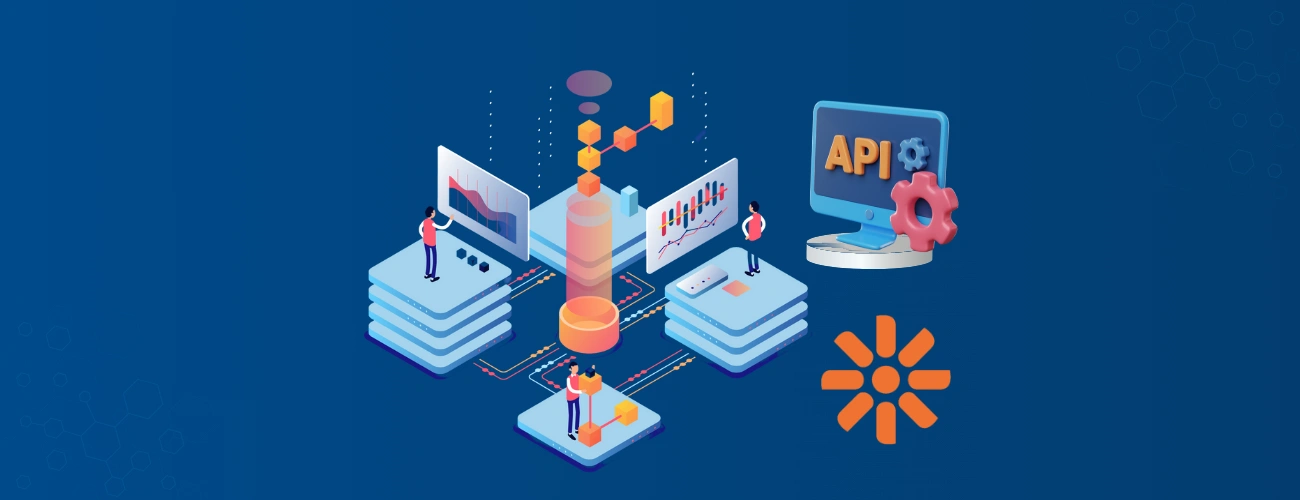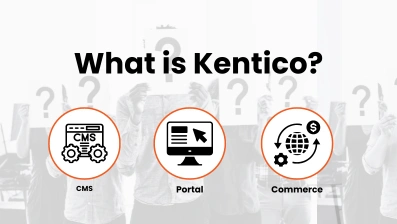In today's fast-paced digital landscape, content management systems (CMS) like Kentico are the backbone of many successful online businesses. But here’s the thing: no matter how powerful your CMS is, it’s not a one-size-fits-all solution. That’s where Kentico 3rd party integration comes into play. By seamlessly connecting Kentico with other tools and services, you can create a more dynamic, efficient, and customized online experience.
Whether you’re looking to supercharge your CRM, automate your marketing efforts, or integrate advanced analytics, Kentico API is your gateway to making it all happen. These integrations not only enhance your website's functionality but also drive better business outcomes, making your operations smoother and more scalable.
In this blog, we’ll dive into what the Kentico API is, the benefits of integrating third-party services, and how you can leverage these integrations to take your business to the next level. Ready to unlock the full potential of Kentico? Let’s get started!
Understanding Kentico API
So, what exactly is the Kentico API and why should you care?
Simply put, the Kentico API is the bridge that connects your Kentico platform to other applications, services, or systems. It’s the tool that allows developers to extend Kentico’s out-of-the-box capabilities and create truly customized digital experiences.
Think of the Kentico API as the engine under the hood of your website. It empowers developers to interact with Kentico at a deeper level, whether it’s pulling data from external sources, pushing data into Kentico, or automating complex workflows. The real beauty of the Kentico API lies in its flexibility—it supports a variety of protocols like REST, SOAP, and even GraphQL, giving you the freedom to choose the right method for your specific needs.
But it’s not just about adding functionality. Using the Kentico API for 3rd party integrations can dramatically improve your site’s performance, scalability, and user experience. It allows you to connect your Kentico site with virtually any other tool or service you need, from CRM systems to eCommerce platforms, all while maintaining a seamless user experience.
In the next sections, we’ll explore the tangible benefits of these 3rd party integrations and walk you through common scenarios where they make a huge impact. Stay tuned, because this is where the magic happens!
Benefits of Kentico 3rd Party Integrations
Integrating Kentico with third-party tools is like giving your website a superpower boost. Whether you're looking to streamline your operations or deliver a top-notch customer experience, Kentico 3rd party integrations have got you covered. Let’s break down some of the key benefits.
1. Enhanced Business Operations
When you integrate Kentico with your CRM, ERP, or other business systems, you create a unified ecosystem where data flows seamlessly between platforms. This means no more manual data entry, fewer errors, and more time for your team to focus on what really matters—growing your business. Imagine your CRM automatically updating with customer interactions from your Kentico site, or your inventory system syncing in real-time with your online store. That’s the power of integration.
2. Improved Customer Experience
Today's customers expect personalized, consistent experiences across all touchpoints. By leveraging Kentico API for integrations, you can deliver just that. Integrating with marketing automation tools allows you to tailor your messaging based on customer behavior on your website. For example, you can trigger personalized email campaigns or offer recommendations based on past purchases—all automated and synced with Kentico.
3. Access to Advanced Analytics
Data is king, and with the right Kentico integrations, you can unlock deeper insights into your website’s performance and user behavior. By connecting Kentico to powerful analytics platforms like Google Analytics or Power BI, you can track every interaction, understand user journeys, and make data-driven decisions to optimize your site. This level of insight is crucial for staying ahead in a competitive market.
4. Future-Proofing Your Business
As your business grows, your needs will evolve. Kentico 3rd party integrations ensure that your digital ecosystem can grow with you. Whether you need to add new tools, scale your operations, or adapt to new market trends, integrating with Kentico is a scalable solution that will support your business every step of the way.
By now, you can see that Kentico 3rd party integrations are not just a nice-to-have—they’re a must-have for any business looking to maximize the potential of its digital presence. In the next section, we'll dive into common scenarios where these integrations can truly make a difference.
Common Scenarios for Kentico Integrations
When it comes to Kentico 3rd party integrations, the possibilities are practically endless. But let’s focus on a few common scenarios where these integrations can transform how you do business. Whether you're managing customer relationships, running an online store, or driving targeted marketing campaigns, Kentico has got you covered.
1. CRM Integration
One of the most popular uses of Kentico API is integrating with Customer Relationship Management (CRM) systems like Salesforce or Microsoft Dynamics 365. By syncing Kentico with your CRM, you can ensure that all customer interactions are tracked in one place. This means your sales and marketing teams always have up-to-date information, leading to more personalized and effective customer interactions. For instance, when a user fills out a form on your Kentico site, their details can automatically populate in your CRM, triggering follow-up actions.
2. eCommerce Platform Integration
Running an online store? Kentico can seamlessly integrate with eCommerce platforms like Shopify or WooCommerce. This integration ensures that your product catalogs, pricing, and inventory levels are always up-to-date across all platforms. Plus, you can offer a smooth, consistent shopping experience by syncing customer data and purchase history between Kentico and your eCommerce system. Imagine having all your sales data, customer preferences, and inventory management tools working together in perfect harmony.
3. Marketing Tools Integration
Kentico plays exceptionally well with marketing automation tools like HubSpot or Marketo. Integrating these tools with Kentico allows you to create powerful, data-driven marketing campaigns. You can track user behavior on your site, trigger automated email campaigns, and nurture leads with personalized content—all while ensuring that your marketing efforts are synchronized across platforms. This integration not only saves time but also enhances the effectiveness of your marketing strategies.
4. Analytics Platform Integration
Understanding how users interact with your website is crucial for making informed decisions. By integrating Kentico with analytics platforms like Google Analytics or Power BI, you can gain deeper insights into user behavior, conversion rates, and content performance. These insights allow you to optimize your website, improve user experience, and drive better business outcomes. For example, you can track the entire customer journey from the moment they land on your site to the point of conversion, all within a unified analytics dashboard.
These scenarios highlight just a few ways that Kentico 3rd party integrations can make your business more efficient, effective, and responsive to customer needs. In the next section, we’ll cover some of the technical considerations you should keep in mind when implementing these integrations.
Technical Considerations for Kentico Integrations
When diving into Kentico 3rd party integrations, it's essential to keep some technical aspects in mind. These considerations ensure that your integrations are not only functional but also secure and scalable. Let’s walk through the key points you should focus on.
1. API Protocols Supported by Kentico
The Kentico API supports multiple protocols, including REST, SOAP, and GraphQL. Each of these protocols has its own strengths and use cases. For instance, REST is known for its simplicity and wide adoption, making it a go-to choice for many developers. SOAP, on the other hand, offers a more rigid structure and built-in error handling, which can be useful for complex integrations. GraphQL provides flexibility by allowing clients to request only the data they need, reducing payload size and improving performance. Understanding these protocols and choosing the right one for your integration is crucial for optimizing performance and maintaining compatibility.
2. Security Practices for Integrations
Security should be a top priority when integrating Kentico with third-party services. Ensure that all data transmitted between Kentico and external systems is encrypted using HTTPS. Implement authentication mechanisms like OAuth to secure API endpoints, and regularly update your systems to patch any vulnerabilities. Additionally, consider using rate limiting and monitoring tools to protect your API from abuse and ensure that only authorized users can access sensitive data. By following these best practices, you can prevent security breaches and protect your users' data.
3. Data Synchronization and Consistency
One of the biggest challenges in 3rd party integrations is ensuring that data remains consistent across systems. When integrating Kentico with CRM, eCommerce, or other platforms, you need to establish clear rules for data synchronization. This includes defining how often data should be synced, handling conflicts between systems, and ensuring that updates in one system are accurately reflected in the other. For instance, if a customer updates their contact information on your Kentico site, that change should automatically sync with your CRM, and vice versa. Proper data synchronization not only improves user experience but also reduces the risk of data discrepancies.
4. Handling API Limits and Performance
Many third-party services impose limits on API requests, so it's essential to manage these limits effectively. Plan your integration to minimize the number of API calls by caching frequently accessed data or using bulk data processing techniques. Additionally, optimize your API requests to reduce latency and improve response times. Monitoring tools can help you track API usage and performance, allowing you to identify bottlenecks and optimize your integration strategy. By managing API limits and focusing on performance, you can ensure that your Kentico integrations run smoothly, even under heavy loads.
These technical considerations are vital for ensuring that your Kentico 3rd party integrations are robust, secure, and scalable. In the next section, we’ll dive into best practices for implementing these integrations effectively.
Best Practices for Implementing Kentico 3rd Party Integrations
Implementing Kentico 3rd party integrations can be a game-changer for your business, but like any powerful tool, it’s essential to use it wisely. By following best practices, you can ensure that your integrations are smooth, reliable, and scalable. Here’s how to get it right.
1. Planning and Scoping the Integration Project
Before you start, take the time to thoroughly plan and scope your integration project. Understand your business needs and define clear objectives for the integration. What do you want to achieve? Whether it’s improving customer data management with a CRM or enhancing your marketing efforts with automation tools, having a clear goal will guide your decisions throughout the process. Additionally, identify all the systems involved and map out how data will flow between them. This planning phase is crucial for avoiding scope creep and ensuring that everyone on your team is aligned.
2. Ensuring Compatibility and Avoiding Common Pitfalls
Compatibility is key when integrating Kentico with third-party systems. Make sure that the APIs of both Kentico and the external service are compatible and can communicate effectively. Pay close attention to data formats, authentication methods, and error handling. Also, be aware of common pitfalls such as version mismatches or deprecated API features that could disrupt your integration. Testing for compatibility early in the process can save you from headaches down the road.
3. Testing and Optimizing Integrations for Performance
Once your integration is in place, thorough testing is a must. Conduct both functional and non-functional testing to ensure that the integration works as expected under various conditions. This includes testing data synchronization, API request limits, and performance under load. Additionally, continuously monitor the integration for performance issues and optimize as needed. Tools like API monitoring platforms can help you track performance metrics and identify bottlenecks. Regularly revisiting and optimizing your integration ensures that it remains efficient and effective as your business grows.
4. Documentation and Training
Good documentation is essential for maintaining and scaling your Kentico integrations. Document the entire integration process, including API endpoints, data flows, and troubleshooting steps. This will make it easier for your team to manage the integration over time and onboard new developers. Additionally, provide training for your team on how to use and maintain the integration. This ensures that everyone is equipped to handle any issues that arise and can make the most of the integration’s capabilities.
By following these best practices, you can ensure that your Kentico 3rd party integrations are not only successful but also scalable and maintainable in the long term. In the next section, we’ll explore some real-world case studies that demonstrate the power of these integrations.
Dotstark - How a Kentico Development Company Can Help
Navigating the world of Kentico 3rd party integrations can be complex, but you don’t have to do it alone. Dotstark – as a specialized Kentico development company can be your guide, ensuring that your integrations are implemented smoothly and effectively. Here’s how partnering with experts can make all the difference.
1. Expertise in Custom API Development
DotStark brings deep expertise in custom API development. They understand the intricacies of Kentico API and can create tailored solutions that meet your unique business needs. Whether you’re integrating a CRM, eCommerce platform, or marketing tool, these experts know how to leverage Kentico to its fullest potential, ensuring that your systems work together seamlessly.
2. End-to-End Integration Services
From initial planning to ongoing support, Dotstark offers end-to-end integration services. This means they handle everything—from scoping the project and developing the integration to testing, deploying, and maintaining it. By taking a comprehensive approach, they ensure that your integration is not only functional but also scalable and secure.
3. Ongoing Support and Optimization
Technology is constantly evolving, and so are your business needs. We provides ongoing support to ensure that your integrations continue to meet your requirements. They can monitor performance, resolve any issues that arise, and make optimizations as needed. This proactive approach helps you stay ahead of the curve and ensures that your Kentico integrations continue to deliver value over time.
4. Why Choose Us for Kentico Integrations
When it comes to Kentico 3rd party integrations, choosing the right partner is crucial. Our company has a proven track record of delivering successful Kentico integrations that drive real business results. We combine technical expertise with a deep understanding of your business goals to create solutions that are not only powerful but also aligned with your strategic objectives. With our help, you can unlock the full potential of Kentico and transform your digital ecosystem.
Conclusion
Integrating Kentico with third-party tools is more than just a technical task—it’s a strategic move that can elevate your business to new heights. By leveraging Kentico API and partnering with a trusted partner, you can create a seamless, efficient, and powerful digital ecosystem that drives success. Don’t let the complexities of integration hold you back; with the right expertise and tools, the possibilities are endless.
Ready to take your Kentico site to the next level? Contact us today to learn more about our Kentico 3rd party integration services and how we can help you achieve your business goals.
Frequently Asked Questions
The Kentico API is a set of tools and protocols that allows developers to extend the functionality of the Kentico platform. It’s crucial for integrations because it enables Kentico to communicate with other systems, services, and applications, allowing for seamless data exchange and automation across your digital ecosystem.
Kentico can integrate with a wide range of third-party systems, including CRMs (like Salesforce and Microsoft Dynamics), eCommerce platforms (such as Shopify and WooCommerce), marketing automation tools (like HubSpot and Marketo), and analytics platforms (such as Google Analytics and Power BI). The possibilities are vast, and with the right expertise, almost any system can be integrated with Kentico.
Security is a top priority when implementing Kentico 3rd party integrations. By using industry-standard protocols like HTTPS for data transmission, implementing robust authentication methods like OAuth, and following best practices for API security, you can ensure that your integrations are secure and that your data is protected from unauthorized access.
Common challenges include ensuring compatibility between systems, managing data synchronization, and handling API rate limits. It’s also important to maintain performance while avoiding issues like data conflicts or security vulnerabilities. These challenges can be mitigated by careful planning, thorough testing, and working with a development company that has experience in handling such integrations.










 +91 9680599916
+91 9680599916
 vanshika@dotstark.com
vanshika@dotstark.com
